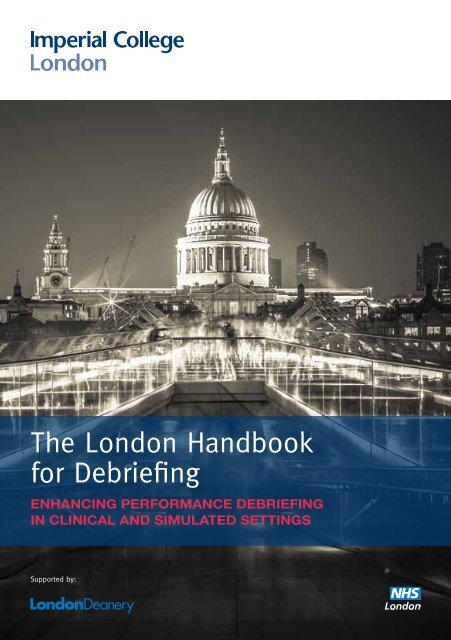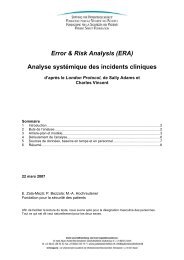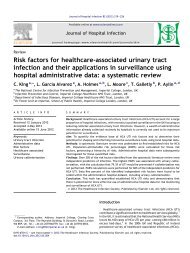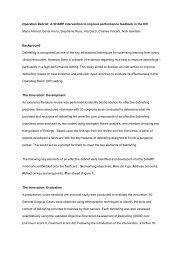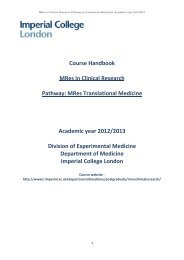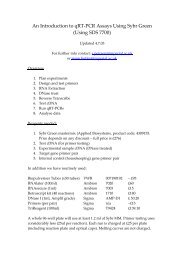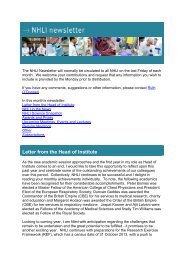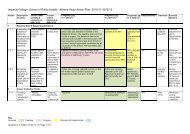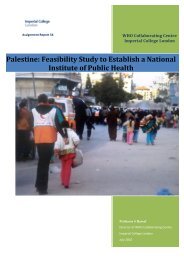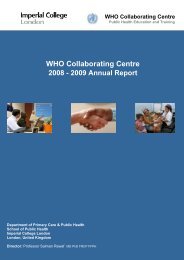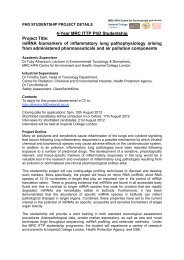The London Handbook for Debriefing - Imperial College London
The London Handbook for Debriefing - Imperial College London
The London Handbook for Debriefing - Imperial College London
Create successful ePaper yourself
Turn your PDF publications into a flip-book with our unique Google optimized e-Paper software.
<strong>The</strong> <strong>London</strong> <strong>Handbook</strong><br />
<strong>for</strong> <strong>Debriefing</strong><br />
Enhancing per<strong>for</strong>mance debriefing<br />
in clinical and simulated settings<br />
Supported by:
Background<br />
<strong>The</strong> fundamental aim of medical<br />
and surgical training is to produce<br />
competent clinicians able to provide the<br />
highest standard of patient care. Quite<br />
how this training is to be delivered is<br />
currently one of the most hotly debated<br />
topics engaging the profession. Drivers<br />
<strong>for</strong> change include increasing concerns<br />
<strong>for</strong> patient safety and reduced working<br />
hours resulting in less opportunity<br />
<strong>for</strong> experiential learning. In an ef<strong>for</strong>t<br />
to address such challenges, there<br />
has been an increased uptake in the<br />
use of simulation to provide trainees<br />
with the necessary knowledge, skills<br />
and attitudes that they will need <strong>for</strong><br />
independent practice.<br />
<strong>The</strong> use of simulators alone does not<br />
guarantee high-quality training, especially<br />
when the skill in question goes beyond<br />
technical competence to involve aspects<br />
of human factors. In addition, running<br />
simulations requires significant faculty<br />
and financial resources. <strong>The</strong>re<strong>for</strong>e,<br />
practices which permit maximal learning<br />
from every clinical encounter, be they in<br />
simulation or in real environments, must<br />
be actively sought.<br />
From this perspective, the role of<br />
structured feedback and debriefing as<br />
part of both simulation and workplacebased<br />
training is of paramount<br />
importance. As an educational strategy,<br />
debriefing following a simulation-based<br />
scenario or clinical encounter, be it on<br />
the ward or in an operating theatre, is<br />
a critical part of the learning process.<br />
Through the use of a mutually engaging<br />
dialogue between the trainee and<br />
trainer, debriefing highlights the lessons<br />
learned by trainees through guided<br />
reflection on their per<strong>for</strong>mance. It also<br />
provides the trainee with an opportunity<br />
to develop strategies <strong>for</strong> applying these<br />
lessons to their daily clinical activities so<br />
as to improve their practice.<br />
Despite this central importance of<br />
debriefing to training, the components of<br />
an educationally effective debriefing and<br />
how best to deliver it remain elusive.<br />
A lack of guidelines on debriefing can<br />
lead to significant variations in practice<br />
which can result in many missed<br />
opportunities <strong>for</strong> learning. Both trainers<br />
and trainees need tools that can allow<br />
<strong>for</strong> systematic, objective feedback to be<br />
provided. Such evidence-based tools<br />
will allow <strong>for</strong> better quality debriefs, more<br />
transparency and higher acceptability in<br />
the provision of feedback.<br />
This handbook provides evidencebased,<br />
user-in<strong>for</strong>med tools<br />
<strong>for</strong> conducting and assessing<br />
debriefings in the real clinical and<br />
simulated setting. <strong>The</strong> tools can be<br />
used <strong>for</strong> adult and paediatric cases.<br />
SHARP Promoting Per<strong>for</strong>mance <strong>Debriefing</strong><br />
OSAD Improving Quality of <strong>Debriefing</strong><br />
# <strong>Imperial</strong> <strong>College</strong> <strong>London</strong> l <strong>The</strong> <strong>London</strong> <strong>Handbook</strong> <strong>for</strong> <strong>Debriefing</strong> <strong>Imperial</strong> <strong>College</strong> <strong>London</strong> l <strong>The</strong> <strong>London</strong> <strong>Handbook</strong> <strong>for</strong> <strong>Debriefing</strong> 1
SHARP Promoting Per<strong>for</strong>mance <strong>Debriefing</strong><br />
What is SHARP<br />
SHARP contains the absolute basic principles of what to cover when conducting a debriefing. SHARP is<br />
an acronym that comprises five ‘prompts’ to guide trainers and trainees in providing/receiving a structured<br />
debrief. SHARP stands <strong>for</strong> Set learning objectives, How did it go, Address concerns, Review learning points,<br />
Plan ahead. It is a practical tool which can be used when there is not enough time to carry out a detailed<br />
debriefing using all the comprehensive in<strong>for</strong>mation provided in the Objective Structured Assessment of<br />
<strong>Debriefing</strong> (OSAD) tool described below.<br />
Who can use SHARP<br />
SHARP can be used by anyone who wants a brief reminder of what to cover in a debriefing in a time-limited<br />
setting. For example, it can be used by a trainer to provide feedback to their trainee immediately after a<br />
case in theatre. It can also be used, <strong>for</strong> example by a paediatric trainee to help structure their feedback<br />
when discussing management of a seriously ill child with their trainer. Ideally SHARP should be used by both<br />
trainee and trainer in order to ensure joint responsibility <strong>for</strong> the debriefing.<br />
“<br />
“SHARP <strong>for</strong>ces you to sit<br />
down and talk… make every<br />
moment count.”<br />
Consultant Trainer<br />
“It could be implemented into<br />
routine practice like at the<br />
end of the case ‘Have you<br />
done your SHARP’”<br />
Consultant Trainer<br />
”<br />
For what can SHARP be used<br />
SHARP can be used as a practical aide memoire to help conduct a debriefing ‘on the ground’. It can be<br />
used by a simulation instructor, <strong>for</strong> example, to remind trainees of the points that need to be covered in the<br />
post-scenario debriefing. Here SHARP could also be placed as a poster in the debriefing room. Clinically,<br />
SHARP can be carried in a credit card sized <strong>for</strong>mat in the pocket of a trainer and then brought out at the end<br />
of the case to aid debriefing.<br />
Unlike OSAD (see below), it is not an assessment tool. <strong>The</strong> five prompts of SHARP map onto the<br />
components of high quality debriefing described in OSAD. Both tools are designed to complement each<br />
other and can be used together. For example, SHARP could be used by a trainer to conduct a debriefing<br />
and OSAD by a researcher who observes their skills in debriefing to determine how effective they are when<br />
using SHARP.<br />
How should SHARP be used<br />
Be<strong>for</strong>e conducting a debriefing with a trainee, trainers should first familiarise themselves with the<br />
components of SHARP so that they are com<strong>for</strong>table using it. <strong>The</strong> first prompt ‘Set learning objectives’ should<br />
be completed be<strong>for</strong>e the case or simulation scenario commences. <strong>The</strong> remaining four prompts should be<br />
discussed after the case. It is recommended that this is done as soon as possible to ensure immediacy of<br />
feedback. No training is required in order to use the SHARP tool.<br />
<strong>The</strong> Evidence <strong>for</strong> SHARP<br />
SHARP was developed based upon the findings of a comprehensive literature review and an international<br />
interview study with end users from three continents regarding the components of effective debriefing. <strong>The</strong>se<br />
were distilled into the five key prompts that <strong>for</strong>m the basis of SHARP using an international expert panel.<br />
A clinical study using SHARP highlighted how it significantly improved feedback and debriefing in the<br />
operating theatre, thereby demonstrating its fitness <strong>for</strong> purpose (see references). In particular, debriefings<br />
were provided to trainees more often (72% of cases when SHARP was not used vs.100% of cases when<br />
SHARP was used). <strong>The</strong> number of cases where learning objectives were set prior to the case significantly<br />
increased from 24% to 86% when SHARP was used. <strong>The</strong> quality of debriefings provided by trainers in the<br />
operating theatre was assessed using OSAD within this study. Results found that there was a significant<br />
improvement in OSAD scores when SHARP was used indicating that the per<strong>for</strong>mance debriefs with SHARP<br />
were also of an objectively higher standard.<br />
2 <strong>Imperial</strong> <strong>College</strong> <strong>London</strong> l <strong>The</strong> <strong>London</strong> <strong>Handbook</strong> <strong>for</strong> <strong>Debriefing</strong> <strong>Imperial</strong> <strong>College</strong> <strong>London</strong> l <strong>The</strong> <strong>London</strong> <strong>Handbook</strong> <strong>for</strong> <strong>Debriefing</strong> 3
SHARP<br />
5-step<br />
feedback<br />
and<br />
debriefing<br />
tool<br />
be<strong>for</strong>e case<br />
Set learning objectives<br />
What would you like to get out of this case<br />
after case<br />
How did it go<br />
What went well Why<br />
Address concerns<br />
What did not go so well Why<br />
Review learning points<br />
Were your learning objectives met <strong>for</strong> this case<br />
What did you learn about your clinical/technical skills<br />
What did you learn about your teamwork skills<br />
trainers thought SHARP<br />
was feasible and easy to<br />
use in busy clinical and<br />
simulated settings<br />
Plan ahead<br />
What actions can you take to improve your future practice<br />
!<br />
Cut out to remove and use<br />
<strong>Imperial</strong> <strong>College</strong> <strong>London</strong> l <strong>The</strong> <strong>London</strong> <strong>Handbook</strong> <strong>for</strong> <strong>Debriefing</strong> 5
““We have SHARP as a poster in the scrub<br />
room. It reminds me to always ask my trainee<br />
at the start of each case what they want to get<br />
out of it...”<br />
Consultant Surgeon<br />
“OSAD helps to define what is really important<br />
when giving feedback. By measuring how we<br />
are doing, we understand where we can further<br />
improve our debriefing practices.”<br />
Consultant Anaesthetist<br />
“Using OSAD has helped me to develop my<br />
skills as a simulation trainer. As my scores get<br />
better, I have become much more confident<br />
in giving feedback – especially when the<br />
simulation has not gone so well.”<br />
Consultant Paediatrician<br />
”<br />
6 <strong>Imperial</strong> <strong>College</strong> <strong>London</strong> l <strong>The</strong> <strong>London</strong> <strong>Handbook</strong> <strong>for</strong> <strong>Debriefing</strong>
OSAD Objective Structured Assessment of <strong>Debriefing</strong><br />
What is OSAD<br />
OSAD is a one page tool which can be used to facilitate debriefings in both real clinical and simulated<br />
settings. It identifies eight core components/categories of effective debriefing i.e. best practice guidelines.<br />
<strong>The</strong>se include the approach of the trainer, establishing a learning environment, learner engagement,<br />
gauging learner reaction, descriptive reflection, analysis of per<strong>for</strong>mance, diagnosis of per<strong>for</strong>mance gaps and<br />
application to future clinical practice. Each category describes poor, average and good practices. If desirable,<br />
each category may also be rated on a scale of 1 (minimum) to 5 (maximum) regarding how well that element<br />
of the debriefing is conducted by the trainer. Descriptive anchors at the lowest point, mid-point, and highest<br />
point of the scale are used to guide ratings. <strong>The</strong> global score <strong>for</strong> OSAD, there<strong>for</strong>e, ranges from a minimum of<br />
8 to a maximum of 40 with higher scores indicating higher quality.<br />
Who can use OSAD<br />
OSAD can be used by anyone who wishes to provide high-quality debriefings, <strong>for</strong> example a clinical trainer,<br />
an educator or a simulation instructor. It can also be used by academics who want to robustly assess the<br />
quality of debriefings provided to trainees so as to ensure they are of the highest standard possible.<br />
What can OSAD be used <strong>for</strong><br />
OSAD has several uses which will be dependent upon the local context. Suggested examples are listed below:<br />
1 OSAD as a guide <strong>for</strong> novice debriefers<br />
As OSAD contains a detailed set of components that underpin debriefing, novice simulation instructors/<br />
facilitators or trainers can use the in<strong>for</strong>mation in the <strong>for</strong>m to identify best practices which they can follow.<br />
2 OSAD as an assessment tool<br />
OSAD can be used <strong>for</strong>matively as a rating tool that can measure the skills of the facilitator in providing a<br />
debriefing. Each of the eight components can be rated to provide individual scores <strong>for</strong> that component.<br />
<strong>The</strong>y can also be added together to provide a Global Score <strong>for</strong> <strong>Debriefing</strong> Quality. This can identify what<br />
the facilitator is doing well and where there are gaps requiring improvement.<br />
3 OSAD as a tool to share best practice<br />
Expert facilitators can use OSAD to identify and share best practices in debriefing so as to drive <strong>for</strong>ward<br />
standards in this domain.<br />
4 OSAD in clinical practice<br />
OSAD can be used by clinical trainers who may wish to have a detailed set of evidence-based, userin<strong>for</strong>med<br />
guidelines to refer to when wishing to provide more comprehensive feedback to their trainees,<br />
<strong>for</strong> example in an appraisal session.<br />
5 OSAD <strong>for</strong> research purposes<br />
OSAD can be used by academics interested in evaluating different models of debriefing and comparing<br />
their relative quality and effectiveness. It can also be used to empirically quantify whether an intervention<br />
designed to improve debriefing is actually effective in doing so.<br />
How should OSAD be used<br />
If using OSAD simply as a set of guidelines <strong>for</strong> what to cover in a debriefing, you do not need to worry about<br />
the scoring system. You can use OSAD after reading this handbook and do not require any further <strong>for</strong>mal<br />
training on the tool.<br />
If using OSAD as an assessment tool <strong>for</strong> <strong>for</strong>mative purposes, e.g. to provide feedback to facilitators on<br />
how to improve their debriefing skills, you may wish to consider rater training be<strong>for</strong>e you carry out any<br />
assessments. This ensures the scores that you allocate <strong>for</strong> each component of OSAD are reliable and<br />
accurate.<br />
If using OSAD <strong>for</strong> any high stakes assessments or <strong>for</strong> research purposes, we recommend that you do<br />
receive further training and are calibrated to use the tool. Please contact Dr Sonal Arora on<br />
sonal.arora06@imperial.ac.uk if you require in<strong>for</strong>mation on rater training.<br />
8 <strong>Imperial</strong> <strong>College</strong> <strong>London</strong> l <strong>The</strong> <strong>London</strong> <strong>Handbook</strong> <strong>for</strong> <strong>Debriefing</strong> <strong>Imperial</strong> <strong>College</strong> <strong>London</strong> l <strong>The</strong> <strong>London</strong> <strong>Handbook</strong> <strong>for</strong> <strong>Debriefing</strong> 9
OSAD Objective Structured Assessment of <strong>Debriefing</strong><br />
Practical notes <strong>for</strong> using OSAD to assess the<br />
quality of a debriefing<br />
• Please note you are observing and rating the facilitator in their ability to<br />
conduct a debrief, NOT the learner.<br />
• Please read the entire rating <strong>for</strong>m be<strong>for</strong>e starting the debriefing session to<br />
ensure you observe the facilitator’s behaviours that you are scoring.<br />
• <strong>The</strong>re are 8 categories (see definitions overleaf), <strong>for</strong> which you score the<br />
facilitator on a scale of 1 (done very poorly) to 5 (done very well).<br />
• To help you score, descriptions <strong>for</strong> the observable behaviours <strong>for</strong> scores 1,<br />
3 and 5 are provided. If you decide to score in between these, rate them<br />
as a 2 or 4 accordingly. For example, if you think a particular component of<br />
OSAD is per<strong>for</strong>med better than average (score 3) but is not quite excellent<br />
(score 5), you would give a score of 4.<br />
• Mark your ratings directly onto the OSAD <strong>for</strong>m. Please tick directly onto the<br />
box containing the text that describes the behaviour <strong>for</strong> scores 1, 3 and 5. If<br />
you want to allocate a score of 2 or 4, please place a tick in the empty box<br />
corresponding to these scores.<br />
• For group debriefings, it is important that the facilitator involves all<br />
participants in order to score a 5, and, there<strong>for</strong>e, all behaviourly descriptors<br />
in OSAD refer to “learner(s)”.<br />
• Definitions and examples of some of these behaviours are given below to<br />
guide your scoring.<br />
<strong>Imperial</strong> <strong>College</strong> <strong>London</strong> l <strong>The</strong> <strong>London</strong> <strong>Handbook</strong> <strong>for</strong> <strong>Debriefing</strong> 11
Definitions and exemplar behaviours<br />
Category Definition example of score 1 example of score 5<br />
1. Approach<br />
Manner in which the facilitator conducts the debriefing session,<br />
their level of enthusiasm and positivity when appropriate, showing<br />
interest in the learners by establishing and maintaining rapport and<br />
finishing the session on an upbeat note.<br />
“You made lots of errors in that scenario, which is<br />
poor since I assume that you must have seen that<br />
scenario be<strong>for</strong>e.”<br />
“Let’s start the session with introductions, so we can<br />
understand each other’s backgrounds and previous<br />
experiences.”<br />
2. Establishes learning<br />
environment<br />
Introduction of the simulation/learning session to the learner(s) by<br />
clarifying what is expected of them during the debriefing, emphasising<br />
ground rules of confidentiality and respect <strong>for</strong> others, and<br />
encouraging the learners to identify their own learning objectives.<br />
“I’m not interested in what you see as the purpose<br />
of this session but I know what I want to teach you<br />
about and its very important to me.”<br />
“Please start by explaining what you hope to take<br />
away from this debriefing session. <strong>The</strong> in<strong>for</strong>mation<br />
we discuss remains confidential.”<br />
3. Engagement of learners<br />
Active involvement of all learners in the debriefing discussions, by<br />
asking open questions to explore their thinking and using silence to<br />
encourage their input, without the facilitator talking <strong>for</strong> most of the<br />
debriefing, to ensure that deep rather than surface learning occurs.<br />
“I’m now going to teach you about the correct way<br />
to do things and I’d like you all to keep quiet and<br />
listen to me.”<br />
“As team leader, can you describe to us what was<br />
going on at that point in the scenario Why do you<br />
all think that happened”<br />
4. Reflection<br />
Self-reflection of events that occurred in the simulation/learning<br />
session in a step by step factual manner, clarifying any technical<br />
clinical issues at the start, to allow ongoing reflection from all<br />
learners throughout the analysis and application phases, linking to<br />
previous experiences.<br />
“I can tell you exactly what you did and why you<br />
were doing it in that way.”<br />
“Could you talk through what you observed, right<br />
from the start, in a step by step way, so we are all<br />
clear about the events that occurred”<br />
5. Reaction<br />
Establishing how the simulation/learning session impacted<br />
emotionally on the learners.<br />
“I can’t understand why you are getting upset about<br />
the events in the scenario, it’s never had that impact<br />
on other people.”<br />
“That part appeared very stressful to us observing, how<br />
did you feel at the time Do you think that it impacted<br />
upon the rest of the experience, and in what way”<br />
6. Analysis<br />
Eliciting the thought processes that drove a learner’s actions, using<br />
specific examples of observable behaviours, to allow the learner to<br />
make sense of the simulation/learning session events.<br />
“<strong>The</strong>re’s no point asking you why you did that but<br />
you should know to do it differently next time.”<br />
“Why do you think that event happened at that<br />
particular moment So what was distracting you<br />
then”<br />
7. Diagnosis<br />
Enabling the learner to identify their per<strong>for</strong>mance gaps and<br />
strategies <strong>for</strong> improvement, targeting only behaviours that can be<br />
changed, and thus providing structured and objective feedback on<br />
the simulation/learning session.<br />
“That was all fine I suppose but I don’t think you<br />
did anything particularly well.”<br />
“So you identified that your team was not aware<br />
how concerned you were, can you suggest ways in<br />
which you could communicate your concerns more<br />
clearly next time”<br />
8. Application<br />
Summary of the learning points and strategies <strong>for</strong> improvement<br />
that have been identified by the learner(s) during the debrief and<br />
how these could be applied to change their future clinical practice.<br />
“So you’ll do better next time I think you know what<br />
you did wrong in the scenario. Let’s finish there.”<br />
“Can you summarise the key points you learnt from<br />
this session How do you think you might change<br />
the way you manage the situation if faced with it<br />
again in your clinical workplace”<br />
12 <strong>Imperial</strong> <strong>College</strong> <strong>London</strong> l <strong>The</strong> <strong>London</strong> <strong>Handbook</strong> <strong>for</strong> <strong>Debriefing</strong> <strong>Imperial</strong> <strong>College</strong> <strong>London</strong> l <strong>The</strong> <strong>London</strong> <strong>Handbook</strong> <strong>for</strong> <strong>Debriefing</strong> 13
OSAD Objective Structured Assessment of <strong>Debriefing</strong><br />
1 2 3 4 5<br />
(done very poorly)<br />
(done very well)<br />
1. Approach<br />
Confrontational, judgmental approach<br />
Attempts to establish rapport with the<br />
learner(s) but is either over- critical or too<br />
in<strong>for</strong>mal in their approach<br />
Establishes and maintains rapport<br />
throughout; uses a non- threatening<br />
but honest approach, creating a<br />
psychologically safe environment<br />
2. Establishes learning<br />
environment<br />
Unclear expectations of the learner(s); no<br />
rules <strong>for</strong> learner(s) engagement<br />
Explains purpose of the debriefing or<br />
learning session but does not clarify<br />
learner(s) expectations<br />
Explains purpose of debrief and<br />
clarifies expectations and objectives<br />
from the learner(s) at the start<br />
3. Engagement of<br />
learners<br />
Purely didactic; facilitator doing all of the<br />
talking and not involving passive learner(s)<br />
Learner(s) participates in the discussion<br />
but mostly through closed questions;<br />
facilitator not actively inviting<br />
contributions from more passive<br />
learner(s)<br />
Encourages participation of learner(s)<br />
through use of open-ended<br />
questions; invites learner(s) to actively<br />
contribute to discussion<br />
4. Reflection<br />
No acknowledgment of learner(s) reactions,<br />
or emotional impact of the experience<br />
Asks the learner(s) about their feelings<br />
but does not fully explore their reaction<br />
to the event<br />
Fully explores learner(s) reaction to<br />
the event, dealing appropriately with<br />
learner(s) who are unhappy<br />
5. Reaction<br />
No opportunity <strong>for</strong> self- reflection; learner(s)<br />
not asked to describe what actually<br />
happened in the scenario<br />
Some description of events by facilitator,<br />
but with little self-reflection by learner(s)<br />
Encourages learner(s) to self-reflect<br />
upon what happened using a step<br />
by step approach<br />
6. Analysis<br />
Reasons and consequences of actions are<br />
not explored with the learner(s)<br />
Some exploration of reasons and<br />
consequences of actions by facilitator<br />
(but not learner(s)), but no opportunity to<br />
relate to previous experience<br />
Helps learner(s) to explore reasons<br />
and consequences of actions,<br />
identifying specific examples and<br />
relating to previous experience<br />
7. Diagnosis<br />
No feedback on clinical or teamwork skills;<br />
does not identify per<strong>for</strong>mance gaps or<br />
provide positive rein<strong>for</strong>cement<br />
Feedback provided only on clinical<br />
(technical) skills; focuses on errors and<br />
not purely on behaviours that can be<br />
changed<br />
Provides objective feedback on<br />
clinical (technical) and teamwork<br />
skills; identifies positive behaviours<br />
in addition to per<strong>for</strong>mance gaps,<br />
specifically targeting behaviours that<br />
can be changed<br />
8. Application<br />
No opportunity <strong>for</strong> learner(s) to identify<br />
strategies <strong>for</strong> future improvement or to<br />
consolidate key learning points<br />
Some discussion of learning points and<br />
strategies <strong>for</strong> improvement but lack of<br />
application of this knowledge to future<br />
clinical practice<br />
Rein<strong>for</strong>ces key learning points<br />
identified by learner(s) and highlights<br />
how strategies <strong>for</strong> improvement<br />
could be applied to future<br />
clinical practice<br />
14 <strong>Imperial</strong> <strong>College</strong> <strong>London</strong> l <strong>The</strong> <strong>London</strong> <strong>Handbook</strong> <strong>for</strong> <strong>Debriefing</strong> <strong>Imperial</strong> <strong>College</strong> <strong>London</strong> l <strong>The</strong> <strong>London</strong> <strong>Handbook</strong> <strong>for</strong> <strong>Debriefing</strong> 15
<strong>The</strong> Evidence behind OSAD<br />
OSAD was developed in order to provide best practice, evidence-based guidelines<br />
<strong>for</strong> conducting debriefings in the simulated and real clinical setting.<br />
<strong>The</strong> approach to development and validation of OSAD consisted of three phases<br />
(Figure 1). This included a systematic review of the literature and interviews with<br />
end-users (including both trainers and trainees in Anaesthetics, Surgery, Paediatrics<br />
and Nursing Care) across the world to ensure it was appropriate to their needs.<br />
Robust testing in the real clinical and simulated setting has provided evidence <strong>for</strong><br />
OSAD’s feasibility, reliability and validity. <strong>The</strong> psychometric properties of OSAD are<br />
reviewed in the Box 1 overleaf. More detailed findings are published in peer-reviewed<br />
journals found in the references section of this handbook.<br />
Systematic<br />
literature review<br />
User needs analysis<br />
(interview study)<br />
PHASE 1<br />
Expert consensus<br />
group<br />
Development of best practice guidelines<br />
<strong>for</strong> debriefing (OSAD)<br />
PHASE 2<br />
Application of OSAD to simulation-based settings<br />
to provide evidence <strong>for</strong> reliability and validity<br />
PHASE 3<br />
Application of OSAD to the real clinical setting<br />
(operating theatre) to confirm feasibility,<br />
acceptability and psychometric properties<br />
OSAD was developed in order to<br />
provide best practice, evidencebased<br />
guidelines <strong>for</strong> conducting<br />
debriefings in the simulated and<br />
real clinical setting<br />
Figure 1<br />
<strong>Imperial</strong> <strong>College</strong> <strong>London</strong> l <strong>The</strong> <strong>London</strong> <strong>Handbook</strong> <strong>for</strong> <strong>Debriefing</strong> 17
Feasible<br />
• Takes only 5 minutes to complete<br />
• Can be used in simulated and real clinical settings<br />
• Can be used in adult and paediatric cases/scenarios<br />
Awards<br />
User-friendly<br />
Evidencebased<br />
• Represents views from clinicians across the world<br />
• Acceptable and appropriate to the needs of the clinical<br />
community<br />
• Drawn from a comprehensive literature review<br />
• Evidence <strong>for</strong> the best practice taken from all fields<br />
of healthcare<br />
This work has received several prestigious, international awards including:<br />
Paper of Distinction Award <strong>for</strong> ‘Objective Structured<br />
Assessment of <strong>Debriefing</strong> (OSAD)’<br />
Awarded by the Association of Surgical Education, Boston 2011<br />
<strong>The</strong> Ron Harden Innovation in Medical Education (RHIME)<br />
Award <strong>for</strong> ‘Operation Debrief: A SHARP intervention to improve<br />
per<strong>for</strong>mance feedback in Surgery’<br />
Presented at the 15th Ottawa Conference on the Assessment of Competence in<br />
Medicine and the Healthcare Professions, Kuala Lumpur 2012<br />
References<br />
Evidence<br />
<strong>for</strong> validity<br />
Evidence<br />
<strong>for</strong> reliability<br />
• OSAD measures what it purports to measure<br />
• Evidence <strong>for</strong> face, content and concurrent validity<br />
• Content Validity Index <strong>for</strong> OSAD = 0.94<br />
• Evidence <strong>for</strong> inter-rater (ICC 0.88) and test-retest reliability<br />
(ICC 0.89)<br />
• OSAD captures quality of debriefings in a consistent manner<br />
• Evidence <strong>for</strong> internal consistency (Cronbach alpha = 0.89)<br />
Arora S, Ahmed M, Paige J, Nestel D, Runnacles J, Hull L, Darzi A, Sevdalis N.<br />
Objective Structured Assessment of <strong>Debriefing</strong> (OSAD): Bringing science to the art of<br />
debriefing in surgery. Annals of Surgery 2012 Aug 14. [Epub ahead of print]<br />
Ahmed M, Arora S, Russ SJ, Darzi A, Vincent C, Sevdalis N. Operation Debrief:<br />
A SHARP improvement in per<strong>for</strong>mance feedback in the Operating Room. Annals of<br />
Surgery (in press 2012)<br />
Ahmed M, Sevdalis N, Paige J, Paragi-Gururaja R, Nestel D, Arora S. Identifying<br />
best practice guidelines <strong>for</strong> debriefing in surgery: A tri-continental study. American<br />
Journal of Surgery 2012 Apr;203(4):523-9<br />
Runnacles, J. Objective Structured Assessment of <strong>Debriefing</strong> (OSAD) in Paediatrics<br />
(MA Clinical Education Dissertation – Distinction, Institute of Education, <strong>London</strong>)<br />
Box 1: Features of OSAD<br />
18 <strong>Imperial</strong> <strong>College</strong> <strong>London</strong> l <strong>The</strong> <strong>London</strong> <strong>Handbook</strong> <strong>for</strong> <strong>Debriefing</strong> <strong>Imperial</strong> <strong>College</strong> <strong>London</strong> l <strong>The</strong> <strong>London</strong> <strong>Handbook</strong> <strong>for</strong> <strong>Debriefing</strong> 19
Contacts<br />
Project leads and contacts <strong>for</strong> further in<strong>for</strong>mation<br />
Correspondence <strong>for</strong> adults:<br />
Ms Sonal Arora<br />
PhD MRCS MBBS BSc (Hons)<br />
Clinical Academic Lecturer in Surgery<br />
Department of Surgery and Cancer<br />
<strong>Imperial</strong> <strong>College</strong> <strong>London</strong>, UK<br />
Email: sonal.arora06@imperial.ac.uk<br />
Correspondence <strong>for</strong><br />
paediatrics:<br />
Dr Jane Runnacles<br />
MBBS BSc (Hons), MRCPCH,<br />
MA (Clin Ed)<br />
Paediatric Specialist Registrar<br />
Great Ormond Street Hospital, UK<br />
Email: jane.runnacles@gmail.com<br />
Working group:<br />
Sonal Arora PhD<br />
Jane Runnacles MA<br />
Maria Ahmed MPH<br />
Nick Sevdalis PhD<br />
Debra Nestel PhD<br />
John Paige MD<br />
Louise Hull MSc<br />
Libby Thomas MCEM<br />
Stephanie Russ PhD<br />
Ana Wheelock MSc<br />
Danilo Miskovic PhD<br />
Ara Darzi FACS, MD<br />
Charles Vincent PhD<br />
20 <strong>Imperial</strong> <strong>College</strong> <strong>London</strong> l <strong>The</strong> <strong>London</strong> <strong>Handbook</strong> <strong>for</strong> <strong>Debriefing</strong>
www.imperial.ac.uk<br />
Supported by:


